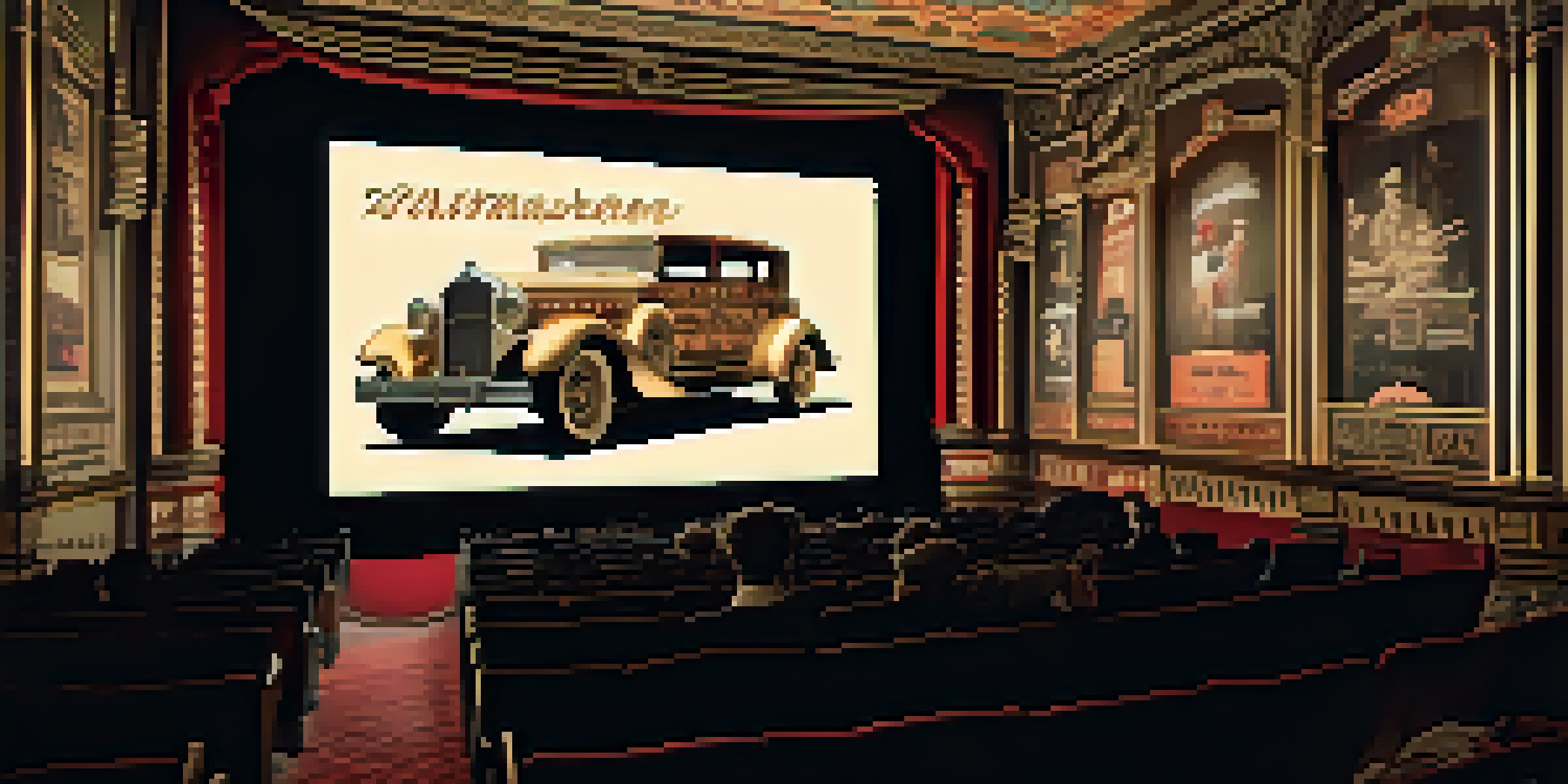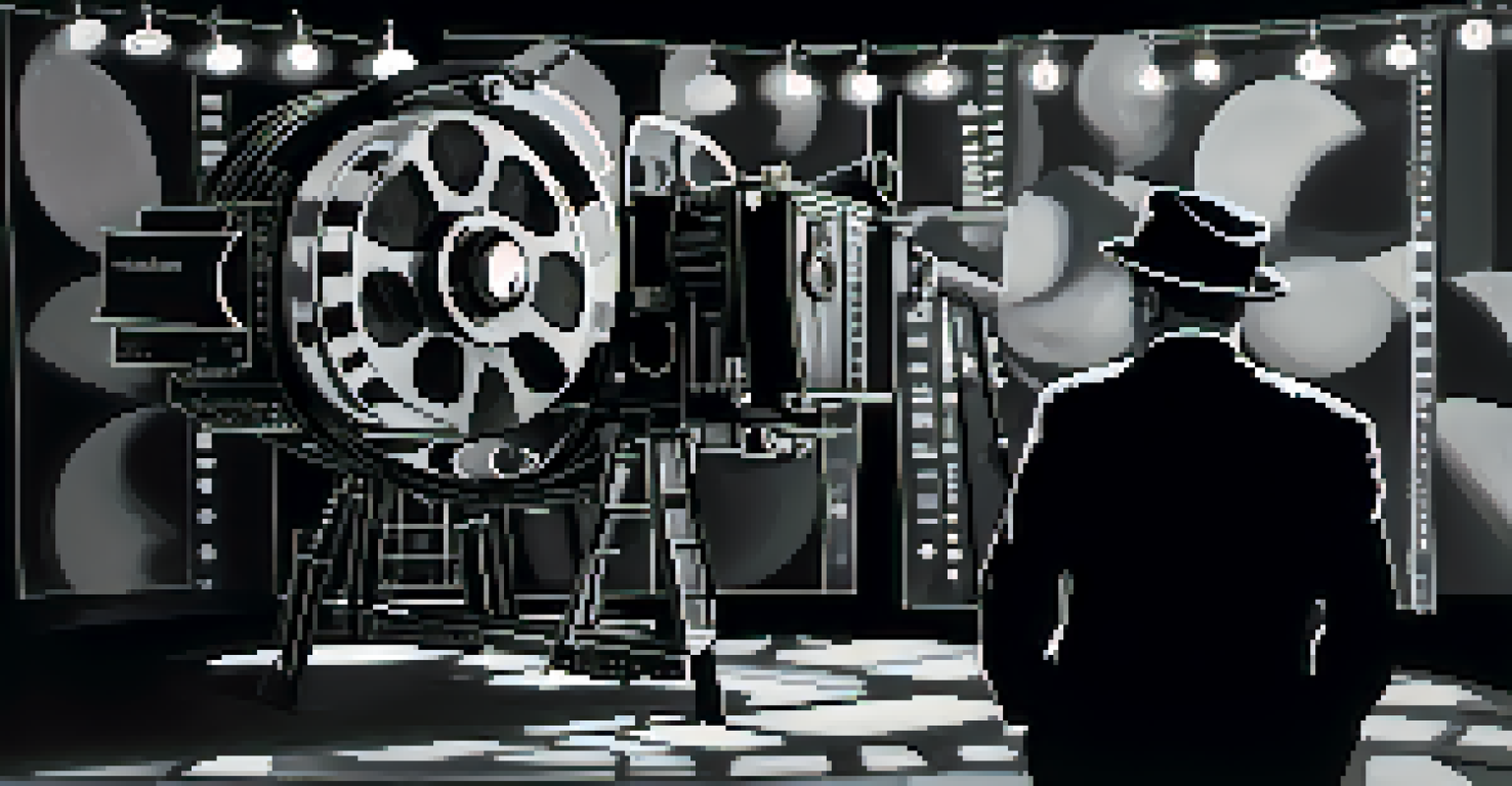How Silent Film Trailers Set the Stage for Future Marketing

The Origins of Silent Film Trailers in Cinema
Silent film trailers emerged in the early 1900s, serving as the first glimpse into upcoming films. These brief previews provided audiences with a taste of the cinematic experience, setting the stage for what was to come. By showcasing key scenes and captivating visuals, they aimed to pique interest and draw viewers to theaters.
The best marketing doesn't feel like marketing.
Unlike today's trailers, silent film previews relied heavily on visuals and text, as dialogue was absent. The clever use of intertitles—text displayed on the screen—helped convey the story and emotions, making it essential for engagement. This reliance on visual storytelling laid the groundwork for techniques still used in modern trailers.
As the film industry grew, so did the significance of these trailers. They became an integral part of the marketing strategy, leading studios to invest more in their production. This early investment hinted at the potential impact trailers could have on box office success.
Crafting a Narrative Without Sound
Silent film trailers had the unique challenge of crafting a narrative without the aid of sound. Filmmakers utilized expressive visuals, dramatic acting, and engaging intertitles to convey their message. This forced creativity encouraged filmmakers to think outside the box, a lesson that modern marketers continue to embrace.

The absence of spoken dialogue meant that every visual element needed to be deliberate and impactful. Directors had to focus on body language and expressive acting to portray emotions effectively. This practice has influenced how trailers are edited today, emphasizing visual storytelling over reliance on dialogue.
Visual Storytelling Drives Engagement
Silent film trailers relied on striking visuals and intertitles to convey narratives, a technique that modern marketers can still leverage to captivate audiences.
Today's marketers can learn from silent trailers by recognizing the power of imagery. Just as the silent era filmmakers had to engage audiences through visuals alone, modern marketers must create compelling content that captures attention in a crowded digital landscape.
The Influence of Visual Aesthetics
Visual aesthetics played a crucial role in the success of silent film trailers. The use of striking imagery, bold typography, and creative editing techniques helped create a unique visual identity. This focus on aesthetics not only attracted viewers but also set a standard for future marketing strategies.
Creativity is intelligence having fun.
Color palettes, lighting, and framing were carefully considered to evoke specific emotions and moods. For example, darker tones might suggest drama or suspense, while brighter colors could hint at comedy or romance. These visual cues are still employed by marketers today to elicit emotional responses from audiences.
Ultimately, the aesthetic choices made in silent film trailers have influenced how visual branding is approached in contemporary marketing. Marketers now understand the importance of creating a cohesive visual identity that resonates with their target audience, just as silent filmmakers did decades ago.
Emphasizing Key Themes and Emotions
Silent film trailers effectively highlighted key themes and emotions, ensuring audiences understood the essence of the story. By focusing on pivotal scenes and character interactions, these previews captured the heart of the film. This practice remains vital in today’s marketing landscape, where conveying the right message can make or break a campaign.
The ability to evoke emotions through visuals allowed silent trailers to connect with audiences on a deeper level. Whether it was the thrill of a chase or the tenderness of a romance, these trailers showcased the core emotional experiences that viewers craved. Modern marketers can take a page from this playbook by prioritizing emotional resonance in their campaigns.
Creating Anticipation is Key
The ability to build excitement and suspense in silent trailers remains crucial in today's marketing strategies to foster audience interest and engagement.
Moreover, the strategic highlighting of themes helped set expectations for viewers, creating anticipation. This approach is mirrored in today’s marketing, where a clear theme can help differentiate a product or service in a saturated market.
Creating Anticipation and Buzz
Silent film trailers mastered the art of building anticipation and buzz around upcoming releases. By teasing exciting scenes and dramatic moments, they left audiences eager for more. This strategy of generating excitement is just as relevant in modern marketing, where creating hype can significantly impact a product's success.
The element of suspense was often woven into trailers, leaving viewers curious about how the story would unfold. This technique encourages potential audiences to discuss and speculate, fostering a sense of community and shared anticipation. Today, marketers continue to use teasers and countdowns to maintain audience engagement leading up to a launch.
In essence, the ability to create buzz through strategic marketing is a timeless technique. The foundations laid by silent film trailers have evolved, but the core principle of generating excitement remains a cornerstone of effective marketing strategies.
The Role of Intertitles in Storytelling
Intertitles were a crucial storytelling device in silent film trailers, providing context and clarity for viewers. These text cards helped convey essential plot points and character motivations, guiding the audience’s understanding. In modern marketing, the use of text in visuals continues to play a significant role in enriching the narrative.
By strategically placing intertitles, filmmakers could emphasize the most important aspects of the story, ensuring that audiences grasped the key elements. This practice has transitioned to contemporary advertising, where taglines and slogans help communicate messages succinctly. The impact of well-crafted text can elevate a campaign and reinforce brand messaging.
Emotional Connection Matters
Highlighting key themes and emotions in silent trailers allowed filmmakers to resonate deeply with viewers, a principle that is just as relevant for contemporary marketing efforts.
Moreover, the balance of visuals and text in silent trailers exemplifies the importance of clarity in storytelling. Modern marketers can learn from this approach by ensuring that their messaging is clear and impactful, allowing consumers to quickly understand the value being offered.
Lessons Learned for Modern Marketing
The evolution of silent film trailers provides valuable insights for modern marketing. Techniques such as visual storytelling, emotional engagement, and creating anticipation have stood the test of time. As marketers analyze these historical strategies, they can adapt them to fit contemporary platforms and audiences.
Understanding the importance of aesthetics, narrative clarity, and audience connection can greatly enhance marketing efforts. Just as silent filmmakers captured the essence of their stories with limited tools, modern marketers must leverage available resources to create compelling narratives that resonate with their target audience.

Ultimately, the legacy of silent film trailers reminds us that the core principles of effective marketing transcend time. By embracing creativity and focusing on audience engagement, marketers can craft campaigns that not only captivate but also inspire action.